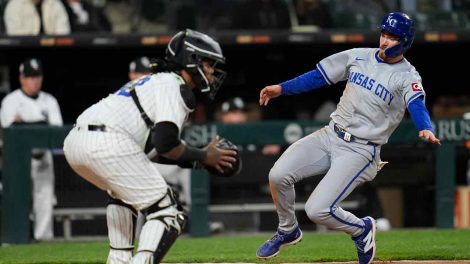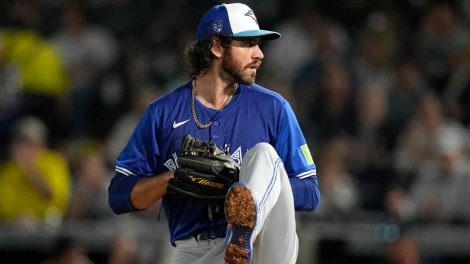PHOENIX – The tendency when thinking of ways to improve a bullpen, quite obviously and understandably, is to look for back-end power arms with swing-and-miss stuff to help shorten games. That’s what every team wants these days, and it’s why free-agent dollars flowed not only to closers but also to set-up men last off-season, as an inability to lock down leads can really undermine a good club.
The Toronto Blue Jays lived that reality with their bullpen at the beginning of last season and again in April and May this year, and though it’s improved, it remains a source of angst thanks to an American League-leading 21 relief losses plus 13 blown saves, which is tied for third. Playing a key role on both fronts has been the bullpen’s struggles with inherited runners, as 46 of 128, or 36 per cent, have come around. That’s tied for the fourth highest percentage in the AL, four per cent above the average, and improving in that area is vital, especially against the better offences as stakes rise.
Manager John Gibbons can’t always hand a clean inning over to his bullpen, and on occasion, the starter or another reliever needs to be bailed out of a jam.
"That’s a thankless role," set-up man Jason Grilli says of coming in with men on base. "You’re sometimes seemingly set up more for failure than for success in that situation, so it takes a special person to grind through that and relish that. … When you look at inherited runners, it’s not a sexy statistic by any means, but on winning ball clubs it’s a huge thing.
"When you look at our division, those swing games can make a big difference. Saving a guy in the ‘pen, keeping your guys fresh, it’s a huge thing."
Worth keeping in mind is that according to Baseball Reference’s Average Leverage Index (one being average, with more than one indicating high pressure and below one indicating low pressure), the Blue Jays bullpen ranks fourth in pressure faced on the mound at 1.037, behind only Houston, the Chicago White Sox and Texas. Their relievers often have little margin for error, with Brett Cecil front and centre in that regard, leading the team at 1.539. For context, closer Roberto Osuna is second at 1.487 and Grilli third at 1.319. Aaron Loup is the only current member of the bullpen below average at .454. The league average is .997.
Pitching so often in leverage is at least partly responsible for some of the bullpen’s issues, as any blip is magnified and a few bad outings can snowball.
"It’s a cliché but you’ve got to have a short memory," says Blue Jays bullpen coach Dane Johnson. "It’s a roller-coaster ride, it’s about forgetting what happened in the last game and having the confidence to go out there and do it again."
When it comes to inherited runners, the Blue Jays have run several pitchers through the role, without finding a go-to arm just yet. Gavin Floyd held that position for a while and allowed just five of 17 inherited runners to score before he was injured last month. Jesse Chavez now has the bulk of opportunities, with 13 of 29 inherited runners scoring. On Sunday in Oakland, he took over from J.A. Happ with two on, two out and a 3-1 lead in the sixth and surrendered a game-tying double to Yonder Alonso. Josh Donaldson ended up winning the game for the Blue Jays with a two-run double in the ninth, but blowing leads like that can be difficult to recover from.
Bo Schultz, who’s stranded all four runners he’s inherited since being recalled late last month following Floyd’s shoulder injury, is earning trust and may emerge as an option for Gibbons. But in an ideal world with the trade deadline looming and back-end relievers sure to be pricey, finding someone who can induce a double play in the sixth or seventh might be an alternative.
"Late inning guys get the microphones and questions and it’s sexy, but sometimes the guy in the middle got the save, truth be told," says Grilli. "I don’t think enough emphasis is put on inherited runners and the guys who do it."
Upon entering tough spots, Johnson preaches to his relievers a focus on throwing strike one, retiring the first batter faced, reading the situation and understanding the thought behind pitch usage, regardless of role.
A key is in not taking on the pressure themselves to record outs, but rather leaving it on the hitters to get on base or deliver hits.
"It’s a chess match, it’s who’s going to get ahead of who, a war of attrition," explains Johnson. "If you get behind in counts, you’re probably going to come fat, or fatter, unless you can come in – and Grilli does a great job of it and he’s passed it on – being able to throw the 2-1 breaking ball, being able to throw the 2-0 breaking ball for a strike and then coming back with it again and then making the hitter think even more. Now you’ve taken the advantage back to your side.
"That’s not easy to do in those situations, to have some intestinal fortitude. That’s what we preach and what we want our guys to do, that way you put the pressure on the hitter and he might chase or you can throw your pitches in those situations."
Grilli emphasizes that when men are on base, relievers must take the mound "sure your stuff is ready and on-point. You have to have at least your bread-and-butter, go-to stuff, confident you can make pitches."
And on days when they’re not feeling at their best?
"Fake it ‘til you make it," he says with a grin.
Another element is reading the game. A reliever who comes on with the men on second and third and one out, for example, is doing his job if he limits the damage to a run. Understanding when to give in and throw a pitch that catches a lot of plate versus when to try and hit the outer edge is crucial.
"Just because you have first and third, it doesn’t mean you don’t have a base open," says Johnson. "You do have a base open if there’s two out and you’re behind in the count. Maybe put this guy on knowing who’s on deck, stuff like that. All that plays into it. No one likes to pitch with the bases loaded but if you’re behind in the count, you’re not going to come fat with something when a walk may not kill you and go after the next guy. An older pitcher understands that better than a younger pitcher."
Old or young, improving with inherited runners is a subtle way for the Blue Jays to get better.










